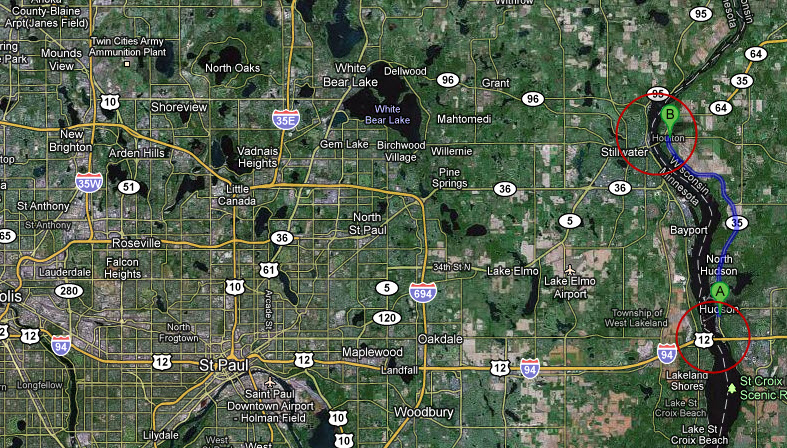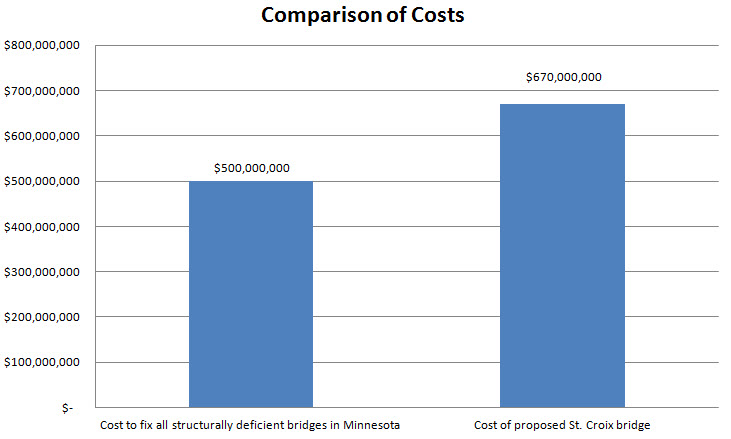Dig, baby, dig
Our systems for funding new infrastructure are stuck in the 1950's. Our systems for funding maintenance of existing infrastructure are not serious. Combined, these approaches create outcomes that can't be justified by people considering themselves rational, let alone great.
Transportation for America has released a report on the state of bridges in the United States. It should be eye-opening for anyone even mildly engaged in the debate over the future of America's infrastructure. Titled "The Fix We're In For: The State of Our Bridges", the report details, in a state-by-state, county-by-county breakdown, exactly where we stand.
For example, in my home state of Minnesota, we have 1,149 bridges that have been determined to be structurally deficient, meaning they require significant maintenance, rehabilitation or replacement. According to Transportation for America, the cost to address all 1,149 bridges is $500 million. But we're not going to focus on this sad fact; others have that covered just fine. Today we're going to look again at the Old Economy Project that Refuses to Die, also commonly called the St. Croix Bridge.
The St. Croix bridge is a proposed $670 million crossing of the St. Croix, a river forming the border between Minnesota and Wisconsin. The city of Stillwater has long advocated for the new bridge as a way to address their congestion problem (the current bridge, which is deficient, runs right through town), to the point where their council gave money to a group promoting the bridge, a contribution which turned out to be illegal. The nearest high-capacity bridge is eight miles away to the south.
 The Stillwater Bridge (B) crosses the St. Croix river about eight miles north of the I-94 bridge near Hudson (A).
The Stillwater Bridge (B) crosses the St. Croix river about eight miles north of the I-94 bridge near Hudson (A).
Let's stipulate for the sake of this conversation that the new St. Croix bridge is a worthy project (it's not, but let's pretend that it is). At a time when Americans are being forced to make some really difficult financial decisions, particularly about infrastructure spending, the reason why this project is likely to proceed while 1,100+ of our deficient bridges receive little funding is important to understand. Understanding that reason will illuminate why we are in such a dire financial situation, why our infrastructure is failing and why nothing we are likely to do will make the problem better.
The St. Croix bridge is a very expensive project. It is projected to cost more than the estimate for fixing ALL of the 1,149 structurally deficient bridges in Minnesota.

Without knowing the numbers, it would be fair to assume that the St. Croix bridge is really critical in terms of traffic volume. Not so. The bridge is projected to carry 16,000 vehicles per day. For comparision, Minnesota's 1,149 structurally deficient bridges carry a combined 2.4 million vehicles per day.

This seems insane, and it is. Why would a state full of rational people spend $670 million on one bridge to carry 16,000 cars when we already have 1,149 bridges carrying over 2.4 million cars that are in a state of critical disrepair? Why would we not spend the money first on maintaining the bridges that we have? What business do we have adding more bridges to the inventory when we do not have the resources to maintain our existing ones?
The answer is so simple and it is the key to understanding why our national infrastructure systems are in such miserable shape.
We can get money from Washington to build new infrastructure, but it is really difficult -- if not impossible -- to get money from Washington to maintain existing infrastructure.
Put simply, maintenance is a local issue. Building new -- expansion -- is something we fund out of Washington D.C. through any number of programs or appropriations. But the catch is always that the drudgery of maintenance falls lower on the government food chain. In other words, it is up to Minnesota to maintain its bridges. There is some federal money there that it can go after, but largely the existing bridges are the states's financial responsibility. The fact that there are 1,149 bridges in critical disrepair points out that this system is not working real well.
Minnesota can say no to the St. Croix bridge money, but in doing so it will not receive an equivalent amount of money that it can use to maintain its existing bridges. If Minnesota says no, the St. Croix bridge money will just go to some other state. Neither the congestion problem in Stillwater nor the problem of the 1,149 deficient bridges will be solved. A pragmatic local politician, understanding that a new bridge solves Stillwater's problems and won't create any significant liabilities for the state for 50 years or more, makes a rational decision and supports the project. Only a handful of people reading this blog right now will be around to bear the financial burden of fixing this bridge when it someday becomes deficient.
Think that through for a second and put yourself in the place of the person fifty years from now. There will be a deficient bridge in Stillwater that will then be in need of maintenance. It will serve only a small number of cars, but the cost will be astronomical -- far more than can be afforded or that can be justified by the traffic volume. Do our grandchildren and great grandchildren put up the money to fix this bridge or do they just ignore the problem?
Well, if they follow in our footsteps, they will ignore the problem. Today we have 1,149 bridges just in Minnesota that were built generations ago that are now ours to maintain. We're not maintaining them.
And why would we? I don't ask that lightly, but simply point out that few of these bridges are high-return investments. The same thought process that is pushing the St. Croix bridge project forward was used to justify all of these other investments. We've not created any systems to ensure that these investment could be financially justified or to capture any value out of them once they were built. With the gas tax, our only incentive at the federal level is to encourage people to use more gas. Building more bridges whenever there was a congestion problem, regardless of whether or not it could be financially justified, responded to this incentive perfectly.
We're two generations into this folly. Look around and see what we've created. We have failing infrastructure everywhere. The cost to maintain it all far outstrips our ability to pay, let alone any amount we could justify spending based on the value created. We've put ourselves into enormous debt not only in government but especially at the household level just trying to keep this system going. So what do we do now?
Apparently, at least for the time being, we just keep digging the hole deeper. Dig, baby, dig.
Related Reading
- The ridiculous old economy project that won't die (November 29, 2010)
- Michele Bachmann and the St. Croix Bridge (March 18, 2010)
- Victory on the St. Croix, but over what? (March 15, 2010)
- The Fix We're In For: The State of Our Nation's Bridges by Transportation for America
- Podcast: The emperor has no clothes (November 10, 2010)
[Note correction: I made a mistake and took a number from the wrong column for the amount of traffic on Minnesota's structurally deficient bridges. The correct number as reported by Transportation for America is 2,436,031. The post now reflects the correct number. My apologies for that mistake. -Chuck Marohn]
